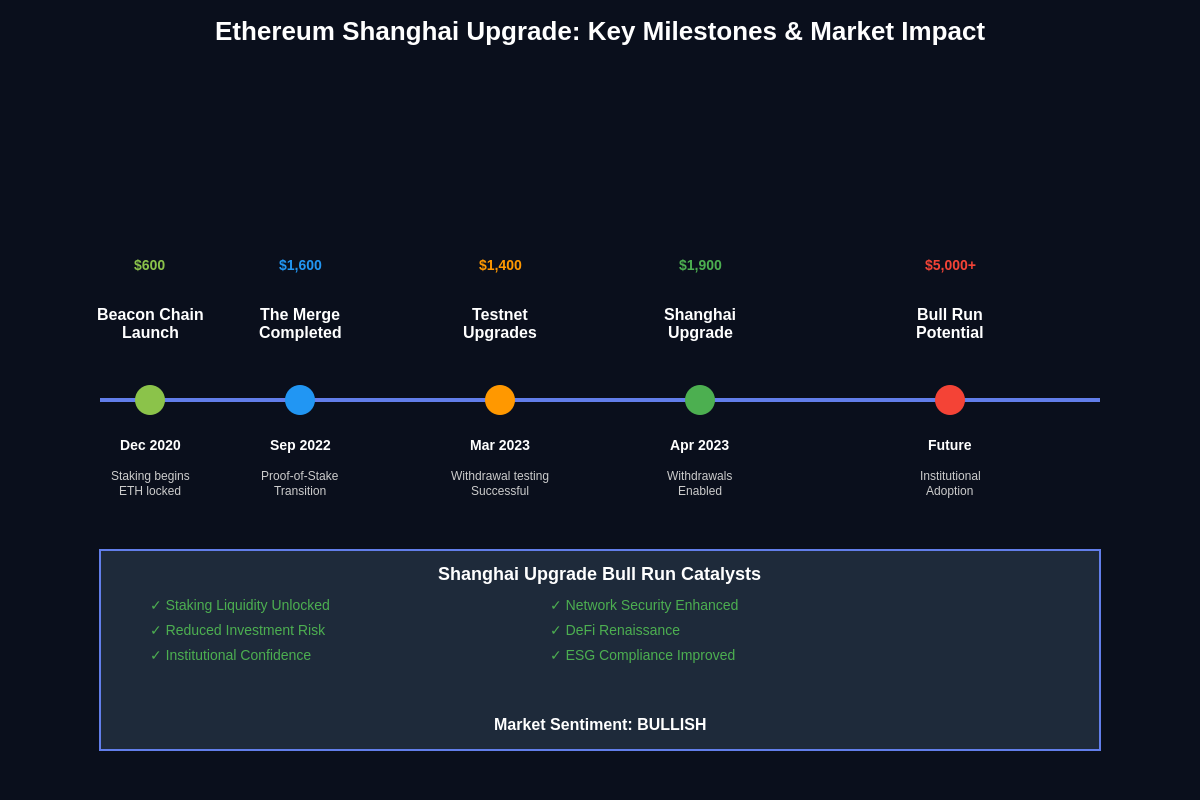
The Foundation for Ethereum’s Next Major Rally
The cryptocurrency market has been eagerly anticipating catalysts that could ignite the next major bull run, and Ethereum’s Shanghai upgrade represents one of the most significant developments in the blockchain ecosystem since the network’s transition to proof-of-stake. This pivotal upgrade has introduced fundamental changes that could reshape the entire cryptocurrency landscape, creating conditions ripe for sustained price appreciation and renewed institutional interest. The Shanghai upgrade’s impact extends far beyond technical improvements, fundamentally altering Ethereum’s economic model and investment proposition in ways that could drive unprecedented demand for the world’s second-largest cryptocurrency.
The upgrade’s most transformative feature is the ability for validators to withdraw their staked ETH, ending a period of forced illiquidity that has locked billions of dollars worth of Ethereum since the Beacon Chain launch. This withdrawal capability has eliminated a major risk factor that previously deterred institutional investors and risk-averse participants from engaging with Ethereum staking. Professional traders monitoring Ethereum’s price movements and technical patterns are closely watching how these fundamental changes impact long-term market dynamics and institutional adoption patterns.
Staking Withdrawal Mechanics and Market Implications
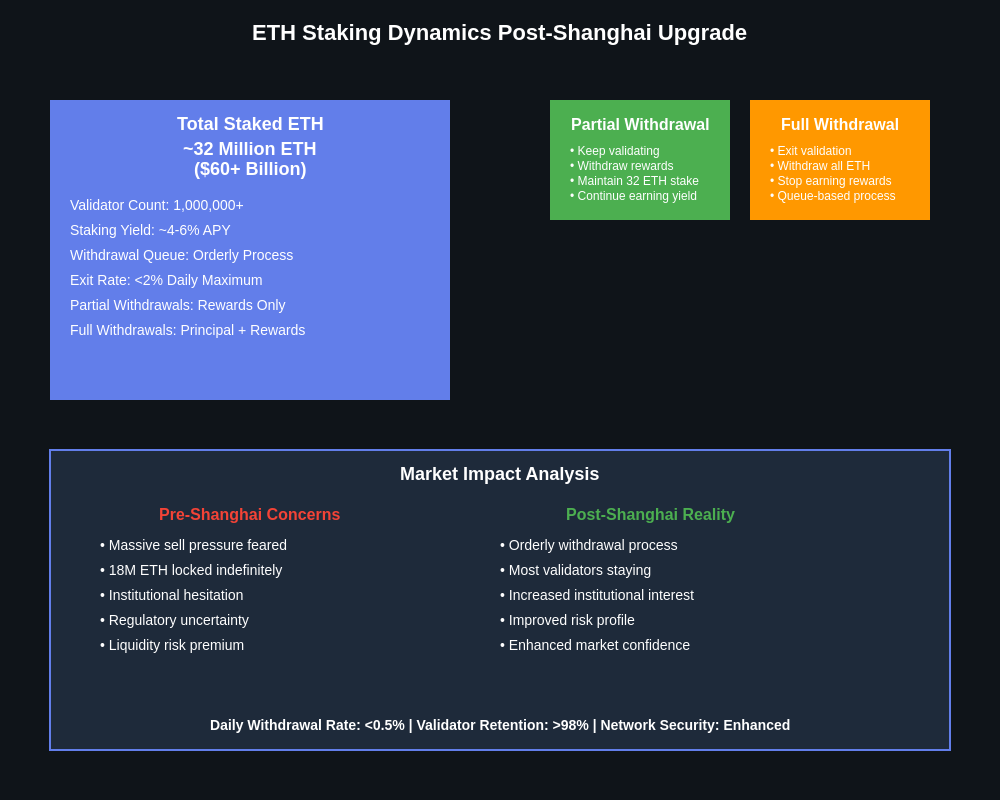
The Shanghai upgrade introduced a sophisticated withdrawal mechanism that allows validators to exit their staking positions in an orderly fashion, preventing the market disruption that many feared would accompany the unlock of approximately 18 million staked ETH. The upgrade implements a withdrawal queue system that processes exit requests gradually, ensuring network stability while providing liquidity to stakers who have been locked into their positions for over two years. This mechanism has proven more market-friendly than anticipated, with initial withdrawal patterns showing that most validators are choosing to remain staked rather than exit entirely.
The withdrawal process operates through two distinct mechanisms that cater to different validator needs and market conditions. Partial withdrawals allow validators to claim their staking rewards while maintaining their validator status, providing regular income streams without disrupting network security. Full withdrawals enable complete exit from validation duties, returning both the original stake and accumulated rewards to the validator. This dual approach has created a more mature and flexible staking ecosystem that appeals to both long-term institutional investors seeking steady yields and tactical investors looking for strategic entry and exit opportunities.
Market analysis reveals that the fear of massive sell pressure from newly liquid staked ETH was largely unfounded, with withdrawal rates remaining well below the maximum theoretical capacity. This restrained withdrawal behavior suggests that many stakers view their positions as long-term investments rather than trading vehicles, creating a natural supply constraint that supports price stability. Advanced technical analysis tools and market indicators show that the orderly withdrawal process has actually strengthened Ethereum’s technical foundation by removing uncertainty about validator behavior and future token supply dynamics.
Enhanced Network Security and Validator Economics
The Shanghai upgrade has significantly strengthened Ethereum’s validator economics by creating a more attractive risk-reward profile for potential stakers. With withdrawal capabilities now available, the effective risk of staking has decreased substantially, encouraging broader participation in network security. This improvement in staking economics creates a positive feedback loop where increased staking participation enhances network security, which in turn increases Ethereum’s value proposition for developers, users, and institutional adopters.
The upgrade has also refined the penalty and slashing mechanisms to create more predictable validator economics while maintaining strong security guarantees. Validators can now plan their staking strategies with greater certainty, knowing they can exit their positions if market conditions change or if they need to reallocate capital. This flexibility has attracted sophisticated institutional investors who previously avoided staking due to liquidity concerns, expanding the validator base and further decentralizing network security.
Enhanced validator economics have created new opportunities for staking derivatives and liquid staking protocols, which enable smaller holders to participate in Ethereum’s proof-of-stake system without meeting the 32 ETH minimum requirement. These protocols have experienced significant growth following the Shanghai upgrade, creating additional utility and demand for ETH while expanding the economic benefits of staking to a broader user base. The proliferation of liquid staking solutions has effectively created new financial products that enhance Ethereum’s ecosystem value and attract different categories of investors.
Institutional Adoption and Regulatory Clarity
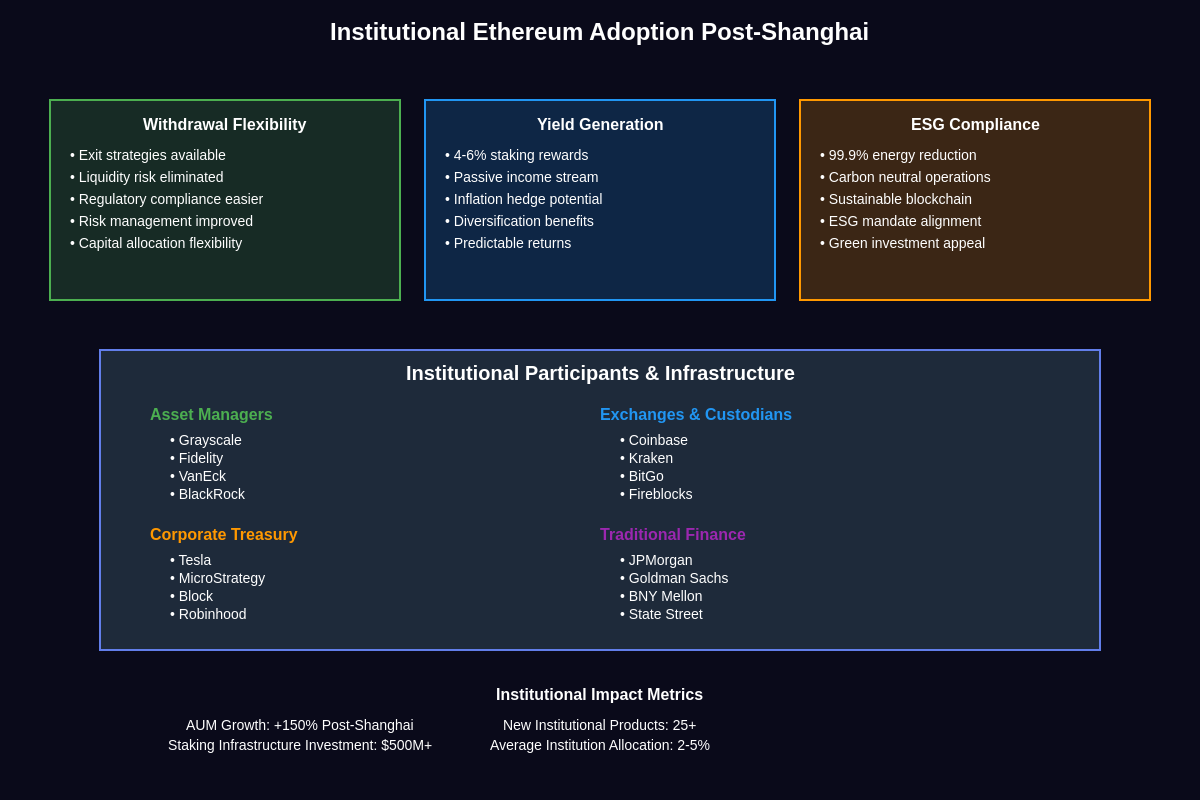
The Shanghai upgrade has addressed several key concerns that previously hindered institutional adoption of Ethereum, particularly around the permanence of staking commitments and the regulatory treatment of locked assets. Financial institutions can now approach Ethereum staking with greater confidence, knowing they can exit positions if regulatory requirements change or if they need to meet liquidity obligations. This flexibility has already begun attracting institutional interest from pension funds, insurance companies, and other large capital allocators seeking yield-generating digital assets.
Regulatory clarity around staking has improved significantly following the upgrade, with clearer guidelines emerging about the treatment of staking rewards and withdrawal mechanisms. Major financial jurisdictions are developing frameworks that recognize the legitimacy of proof-of-stake networks and the institutional-grade security they provide. This regulatory progress creates a foundation for broader institutional participation and potentially opens the door for ETF products based on staked Ethereum, which could drive massive new demand from retail and institutional investors alike.
The upgrade’s impact on institutional adoption extends beyond direct staking participation to include the broader ecosystem of Ethereum-based financial products and services. Traditional financial institutions are increasingly recognizing Ethereum as a foundational infrastructure for digital finance, with many exploring opportunities to build traditional financial products on Ethereum’s secure and scalable platform. Sophisticated investors utilize comprehensive crypto market analysis platforms to evaluate how institutional adoption trends influence long-term price trajectories and ecosystem development.
Layer 2 Scaling Solutions and Network Effects
The Shanghai upgrade has accelerated the development and adoption of Layer 2 scaling solutions by providing a more stable and predictable base layer for these networks to build upon. With withdrawal risks eliminated and validator economics improved, Layer 2 protocols can focus on innovation and user experience rather than concerns about base layer stability. This has led to significant improvements in transaction costs, speed, and functionality across the Ethereum ecosystem, making it more competitive with alternative blockchain platforms.
Layer 2 solutions have experienced dramatic growth in user adoption and transaction volume following the Shanghai upgrade, as developers and users gain confidence in Ethereum’s long-term scalability roadmap. Popular Layer 2 networks like Arbitrum, Optimism, and Polygon have seen substantial increases in total value locked and daily active users, creating network effects that benefit the entire Ethereum ecosystem. These scaling solutions enable Ethereum to handle massive transaction volumes while maintaining the security and decentralization of the main network.
The synergy between the Shanghai upgrade and Layer 2 development has created a compelling value proposition for developers building decentralized applications. Lower transaction costs and faster settlement times on Layer 2 networks, combined with the enhanced security and stability of post-Shanghai Ethereum, provide an ideal environment for innovation in decentralized finance, gaming, NFTs, and other blockchain applications. This combination of scalability and security positions Ethereum as the preferred platform for next-generation blockchain applications.
DeFi Renaissance and Ecosystem Growth
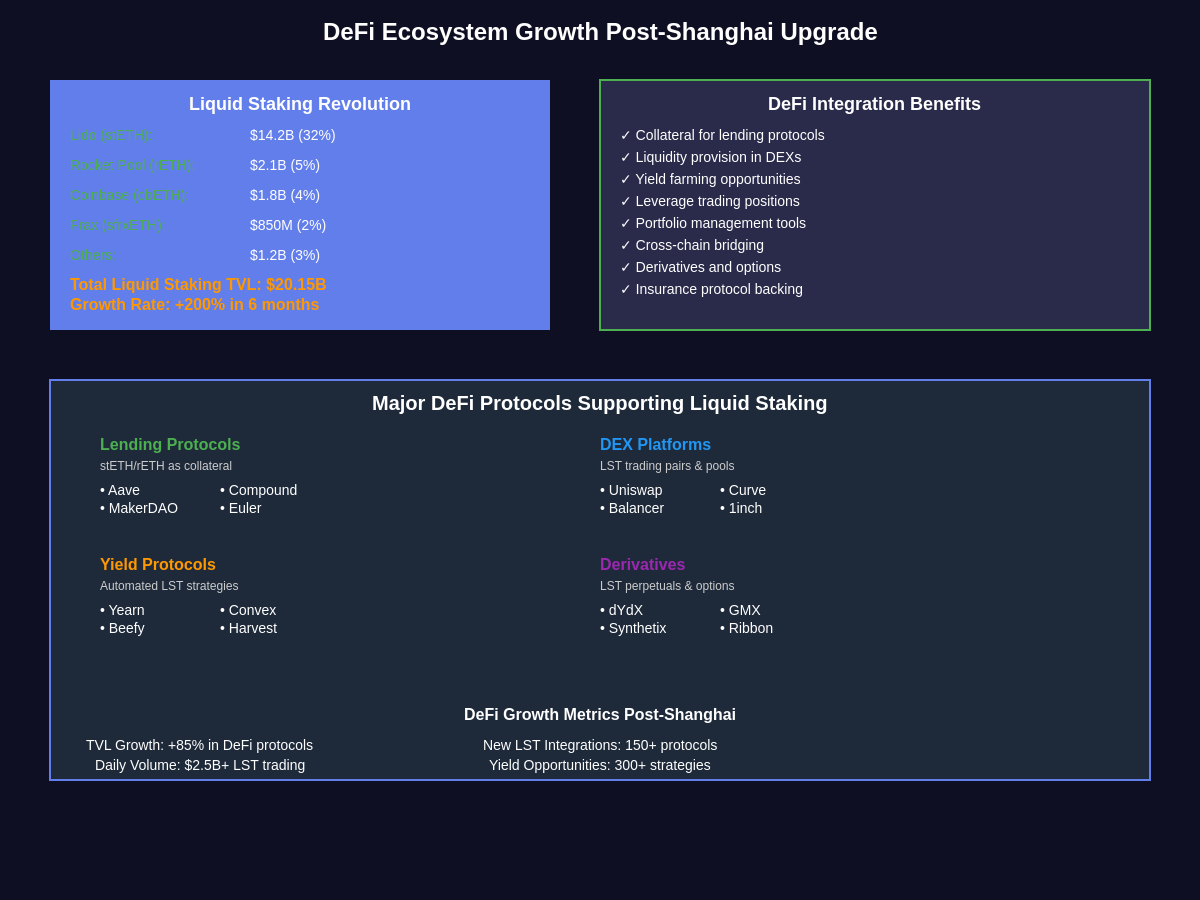
The Shanghai upgrade has catalyzed a renaissance in decentralized finance by eliminating concerns about Ethereum’s long-term viability and creating new opportunities for yield generation and financial innovation. DeFi protocols have experienced renewed growth as users return to the ecosystem with greater confidence in its stability and security. The ability to withdraw staked ETH has also created new liquidity sources for DeFi applications, as stakers can now participate in lending, borrowing, and yield farming activities without completely exiting their validator positions.
Liquid staking derivatives have emerged as a major DeFi primitive following the Shanghai upgrade, enabling stakers to maintain exposure to Ethereum’s proof-of-stake rewards while participating in other DeFi activities. These derivatives create additional utility for staked ETH and enable more sophisticated trading and investment strategies. Major DeFi protocols have integrated support for liquid staking tokens, creating new yield opportunities and expanding the addressable market for Ethereum-based financial products.
The upgrade has also enabled new categories of DeFi products that were previously impossible or impractical due to staking illiquidity constraints. Structured products, options, and other derivatives based on staking yields have emerged, creating additional layers of financial innovation and attracting sophisticated traders and institutional investors. Professional traders tracking DeFi token performance and yield opportunities can now access more diverse and sophisticated investment strategies within the Ethereum ecosystem.
Energy Efficiency and ESG Compliance
The Shanghai upgrade has further solidified Ethereum’s position as an environmentally sustainable blockchain platform, addressing ESG concerns that have become increasingly important for institutional investors. The proof-of-stake consensus mechanism uses approximately 99.9% less energy than proof-of-work systems, making Ethereum attractive to institutions with environmental mandates or sustainability goals. This energy efficiency advantage has become a significant differentiator as regulatory pressure increases on energy-intensive blockchain networks.
Environmental sustainability has become a key factor in institutional cryptocurrency adoption, with many funds and corporations establishing ESG criteria that exclude energy-intensive blockchain investments. Ethereum’s low energy consumption following the merge to proof-of-stake, combined with the stability improvements from the Shanghai upgrade, positions it favorably for ESG-compliant investment strategies. This alignment with environmental goals opens new sources of institutional capital that were previously unavailable to the cryptocurrency sector.
The upgrade’s environmental benefits extend beyond direct energy consumption to include the broader ecosystem effects of supporting sustainable technology development. Ethereum’s platform enables the creation of carbon trading systems, renewable energy certificates, and other environmental applications that can contribute to global sustainability efforts. This utility in addressing climate change and environmental challenges enhances Ethereum’s value proposition for socially conscious investors and institutions.
Technical Improvements and Developer Experience
The Shanghai upgrade has implemented numerous technical improvements that enhance the developer experience and expand the possibilities for building on Ethereum. These improvements include optimizations to the execution layer, enhanced interoperability between Layer 1 and Layer 2 solutions, and better tooling for smart contract development and deployment. The cumulative effect of these improvements is a more robust and developer-friendly platform that attracts talent and innovation to the Ethereum ecosystem.
Smart contract functionality has been enhanced through the upgrade, with new opcodes and improved gas efficiency for common operations. These technical improvements reduce development costs and enable new categories of applications that were previously impractical due to gas limitations. The enhanced technical capabilities have attracted developers from other blockchain platforms and traditional software development, expanding the talent pool working on Ethereum-based projects.
The upgrade has also improved the integration between Ethereum’s consensus and execution layers, creating more predictable performance and enabling better optimization of application architecture. Developers can now build applications with greater confidence in the platform’s stability and performance characteristics, leading to more ambitious and complex projects. This technical foundation supports the development of enterprise-grade applications that can compete with traditional software solutions while providing the benefits of blockchain technology.
Market Psychology and Investor Sentiment
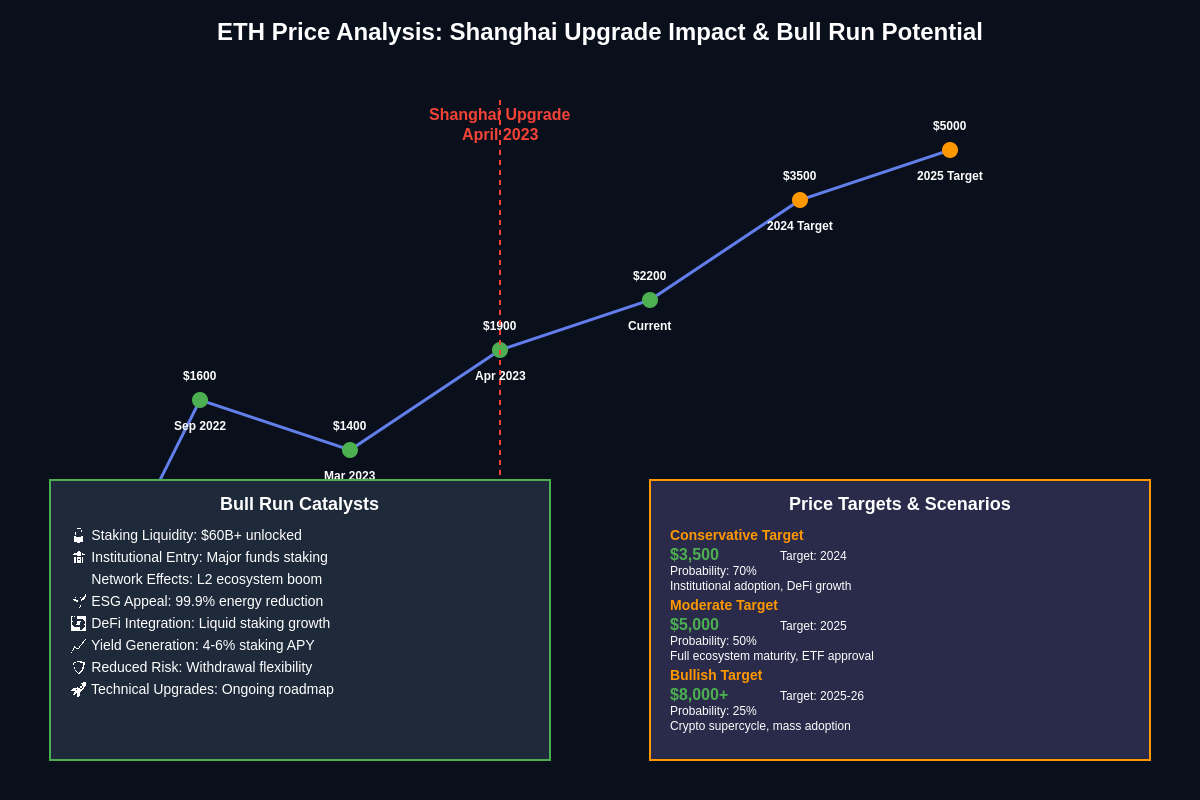
The successful implementation of the Shanghai upgrade has significantly improved market psychology around Ethereum, eliminating the “overhang” effect of locked staking rewards and demonstrating the network’s ability to execute complex technical upgrades without major disruption. This success has increased investor confidence in Ethereum’s development roadmap and its ability to continue evolving to meet changing market demands. The positive sentiment has attracted both retail and institutional investors who were previously concerned about execution risk.
Risk perception around Ethereum has decreased substantially following the upgrade, as investors no longer worry about the potential for validator exits to cause market disruption or network instability. This reduced risk perception has led to higher valuation multiples and increased investment flows from risk-sensitive institutions. The upgrade’s success has also enhanced Ethereum’s reputation as a reliable and well-managed blockchain platform, improving its competitive position relative to other smart contract platforms.
Market sentiment indicators show sustained improvement in investor confidence following the Shanghai upgrade, with metrics like network activity, developer engagement, and institutional interest all showing positive trends. Long-term holders have increased their positions, while trading volumes and price volatility have stabilized at levels consistent with a maturing asset class. Sophisticated market participants using advanced charting and sentiment analysis tools can track these psychological factors and their impact on price discovery and market dynamics.
Competitive Positioning and Network Effects
The Shanghai upgrade has strengthened Ethereum’s competitive position relative to alternative smart contract platforms by addressing key weaknesses while maintaining its advantages in developer ecosystem, institutional adoption, and network effects. Competing platforms that emphasized Ethereum’s staking illiquidity as a weakness can no longer use this argument, while Ethereum continues to benefit from its first-mover advantage and extensive ecosystem. The upgrade has effectively raised the competitive bar for other platforms while solidifying Ethereum’s market leadership.
Network effects have accelerated following the upgrade as increased confidence in Ethereum’s stability attracts more developers, users, and applications to the platform. These network effects create a virtuous cycle where more activity increases the platform’s value, which attracts more participants and further increases activity. The combination of technical improvements, enhanced economics, and reduced risk has made Ethereum more attractive relative to competitors and harder for alternative platforms to challenge.
The upgrade’s impact on Ethereum’s competitive moat extends beyond direct technical advantages to include the broader ecosystem of tools, services, and infrastructure that supports Ethereum development. As confidence in Ethereum’s long-term viability increases, more resources are invested in building supporting infrastructure, creating barriers to entry for competing platforms and making it more difficult for developers and users to switch to alternatives.
Institutional Infrastructure and Custody Solutions
The Shanghai upgrade has accelerated the development of institutional-grade infrastructure for Ethereum, including custody solutions, trading platforms, and risk management tools. Major financial services companies have expanded their Ethereum offerings to include staking services, derivatives products, and asset management solutions. This infrastructure development reduces barriers to institutional adoption and creates new avenues for institutional capital to enter the Ethereum ecosystem.
Custody solutions have evolved to support the complexities of Ethereum staking, including key management for validator operations, reward distribution, and withdrawal processing. These solutions provide the security and operational controls that institutional investors require while enabling participation in Ethereum’s proof-of-stake system. The availability of institutional-grade custody has removed a significant barrier to institutional staking and enabled larger capital allocations to Ethereum.
Professional asset managers have developed new investment products based on Ethereum staking, including managed staking services, structured products, and fund strategies that incorporate staking yields. These products provide institutional investors with exposure to Ethereum’s staking rewards without requiring direct technical expertise or operational capabilities. The proliferation of professional investment products has expanded the addressable market for Ethereum and created new sources of demand.
Future Upgrade Path and Long-term Value Proposition
The Shanghai upgrade represents just one milestone in Ethereum’s ambitious development roadmap, which includes further scalability improvements, privacy enhancements, and user experience optimizations. The successful execution of this complex upgrade demonstrates the Ethereum development community’s ability to deliver on technical commitments and provides confidence in future upgrade plans. This execution capability enhances Ethereum’s long-term value proposition and supports higher valuations based on future potential rather than just current capabilities.
Upcoming upgrades in Ethereum’s roadmap promise to address remaining scalability and cost challenges while maintaining the security and decentralization that distinguish Ethereum from competitors. Features like proto-danksharding, account abstraction, and verkle trees will further enhance Ethereum’s capabilities and expand its addressable market. The clear roadmap and demonstrated execution capability create a compelling investment thesis based on Ethereum’s evolution toward a more scalable and user-friendly platform.
The long-term value proposition of Ethereum has been significantly enhanced by the Shanghai upgrade’s demonstration of the network’s ability to evolve and improve while maintaining stability and security. This adaptability is crucial for maintaining relevance in the rapidly evolving blockchain technology landscape and provides confidence that Ethereum can continue to innovate and compete effectively. Investors analyzing Ethereum’s long-term price potential and technical developments can access detailed fundamental analysis tools to evaluate how upcoming upgrades might impact valuation and market positioning.
Global Economic Context and Digital Asset Adoption
The Shanghai upgrade has positioned Ethereum to benefit from broader trends in digital asset adoption and the ongoing digitization of global financial systems. As central banks explore digital currencies and traditional financial institutions integrate blockchain technology, Ethereum’s mature and stable platform provides an attractive foundation for these developments. The upgrade’s improvements to stability and institutional accessibility align with the requirements of large-scale financial system adoption.
Macroeconomic factors including inflation concerns, currency debasement, and geopolitical uncertainty have increased interest in digital assets as alternative stores of value and investment vehicles. Ethereum’s enhanced stability and yield-generating capabilities make it particularly attractive in this environment, as it provides both capital appreciation potential and income generation through staking rewards. The combination of growth potential and yield makes Ethereum appealing to diverse investor types and economic conditions.
The upgrade has also improved Ethereum’s positioning for integration with traditional financial systems and regulatory frameworks. The predictable economics and withdrawal mechanisms make Ethereum more compatible with existing financial regulations and accounting standards. This compatibility facilitates adoption by traditional financial institutions and reduces regulatory uncertainty for institutional investors.
Risk Factors and Market Dynamics
While the Shanghai upgrade has eliminated many previous risk factors associated with Ethereum, new considerations have emerged that could impact future price performance and adoption. Competition from other blockchain platforms continues to intensify, with some offering different trade-offs between scalability, decentralization, and security. Ethereum must continue to innovate and execute successfully to maintain its competitive advantages and market leadership position.
Regulatory developments remain a significant factor that could impact Ethereum’s adoption and price performance. While current regulatory trends appear favorable, changes in government policy or regulatory interpretation could affect institutional adoption or the broader cryptocurrency market. The global nature of blockchain technology means that regulatory developments in major jurisdictions could have widespread impacts on Ethereum’s ecosystem and price.
Technical risks associated with the complexity of Ethereum’s ongoing development roadmap could potentially impact execution timelines or create unexpected challenges. While the successful Shanghai upgrade demonstrates strong technical capabilities, future upgrades involve additional complexity and potential risks. Market participants must consider these execution risks when evaluating Ethereum’s long-term investment potential and monitor development progress closely.
Investment Implications and Strategic Considerations
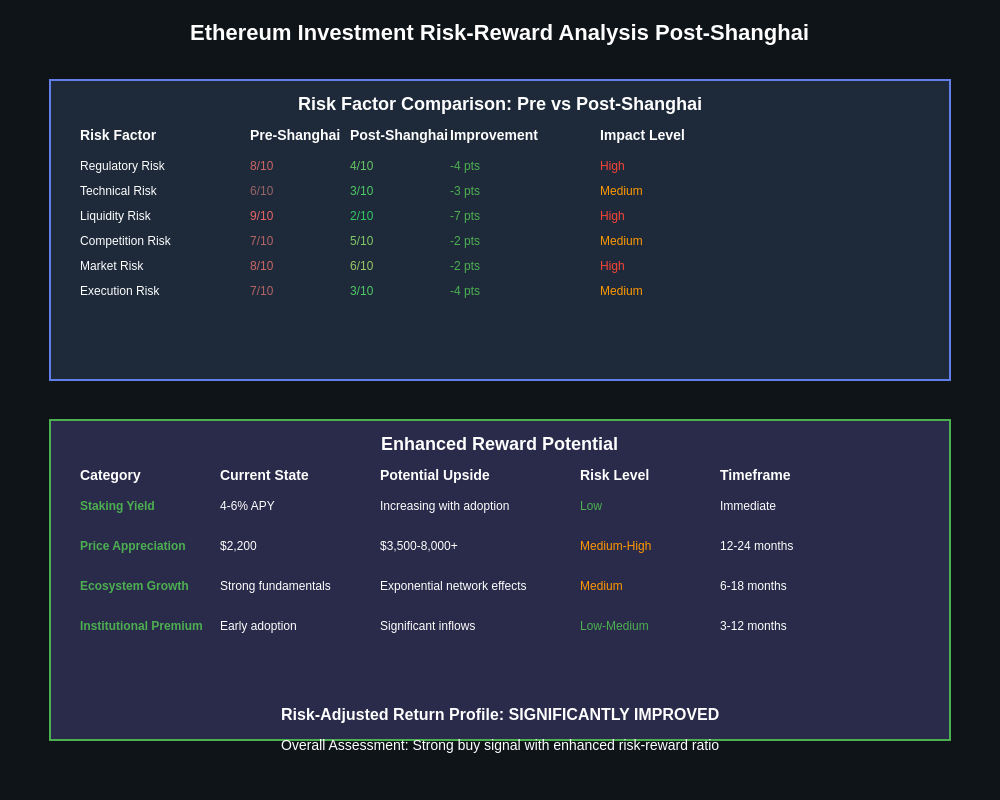
The Shanghai upgrade has fundamentally altered the investment case for Ethereum by improving its risk-reward profile and expanding its addressable market. The combination of eliminated staking risks, improved institutional accessibility, and enhanced network effects creates a compelling foundation for sustained price appreciation. Professional investors are increasingly viewing Ethereum not just as a speculative technology investment but as a foundational digital asset with characteristics similar to digital real estate or infrastructure investments.
Portfolio allocation strategies are evolving to reflect Ethereum’s improved stability and yield-generating capabilities. The ability to earn staking rewards while maintaining exposure to price appreciation provides an attractive risk-adjusted return profile that appeals to both growth and income-oriented investors. This dual return source reduces the need for active trading and supports longer investment horizons, which could contribute to price stability and reduced volatility.
Strategic considerations for Ethereum investment now include factors like staking yield optimization, Layer 2 ecosystem exposure, and positioning for future upgrade benefits. Sophisticated investors are developing multi-faceted approaches that capture value from different aspects of the Ethereum ecosystem while managing risks associated with technical development and market dynamics. Professional traders and institutional investors require sophisticated analytical tools and real-time market data to optimize their strategies and respond effectively to changing market conditions and technological developments.
Disclaimer: This article is for educational and informational purposes only and should not be construed as financial advice. Cryptocurrency investments carry significant risks, including the potential for total loss of capital. Past performance does not guarantee future results, and the Shanghai upgrade’s impact on Ethereum’s price cannot be predicted with certainty. Market conditions, regulatory changes, technical developments, and competitive factors could all impact Ethereum’s performance differently than anticipated. Always conduct your own research and consult with qualified financial advisors before making investment decisions. The author and publisher are not responsible for any financial losses that may occur from acting on the information provided in this article.